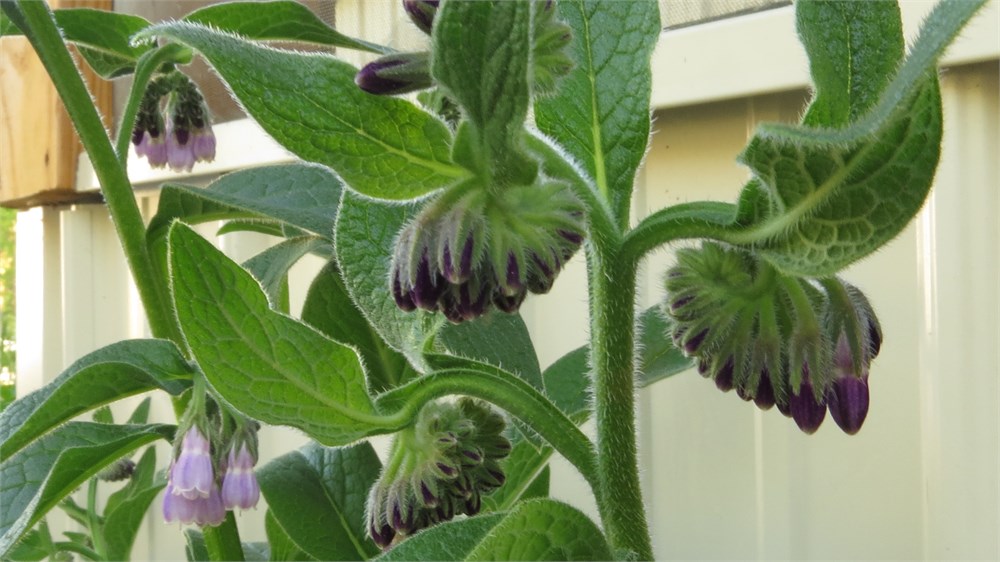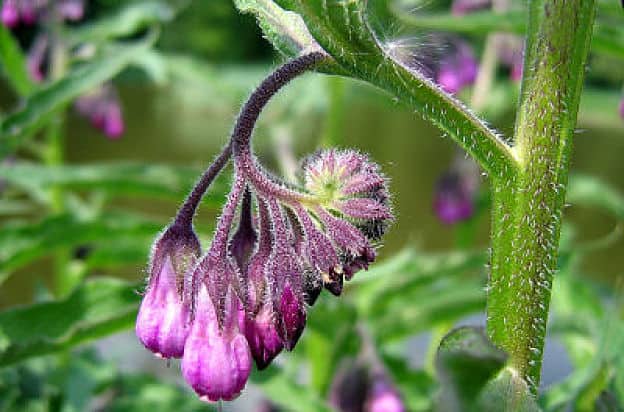
Rosmarinic acid is known for its numerous biological properties proven in different experimental models, such as anti-inflammatory, antioxidant, anticancer, antimicrobial and anti-allergic activities. Polyphenols (e.g., rosmarinic acid, caffeic acid, chlorogenic acid, lithospermic acid, globoidnan A, globoidnan B, rabdosiin, etc.) are the most diverse and well-represented class of comfrey phytochemicals.

Purine derivatives are degradation products of purine bases and nucleotides in particular, allantoin was shown to exert wound healing (fibroblastic proliferation, extracellular matrix synthesis) and immunomodulatory activities. Polysaccharides are considered one of the most potent biomolecules in comfrey, endowed with antioxidant, immunomodulatory, anticancer, hypoglycemic and hypolipidemic effects.

Comfrey contains four major classes of constituents: polysaccharides (up to 30% mucilage), purine derivatives (0.6–4.7% allantoin), polyphenols and pyrrolizidine alkaloids (PAs). These indications are based on the solid scientific knowledge acquired from numerous cell-free, cell-based, animal and human studies that demonstrated the efficacy (wound healing, antimicrobial, anti-inflammatory and anti-nociception potential), safety and tolerability profile of S. Currently, comfrey-based topical applications are administered in the clinical symptomatology (inflammation, pain and swelling of joints and muscles) from arthritis, strains, contusions or sprains. Ethnopharmacologically, different internal (tinctures, infusions, decocts) or external (compresses, ointments) formulations prepared from the roots ( Symphyti radix), leaves ( Symphyti folium) or whole aerial parts ( Symphyti herba) have been empirically used since Ancient times in swellings, bruises, phlebitis, contusions, respiratory, gastro-intestinal and genitourinary disorders. (comfrey) is one of the most well-known and studied species of the Boraginaceae, a family that comprises around 130 genera and 2300 species distributed around the world, in both tropical and temperate regions.
#SYMPHYTUM USES SKIN#
ibericum can be regarded as a prospective source of pharmaceutical or cosmeceutical ingredients with putative uses in the management of chronic conditions linked to oxidative stress, such as Alzheimer’s disease or skin pigmentation disorders. ConclusionsĪs evidenced through the phytochemical characterization and multi-biological evaluation, S. Exploratory multivariate analysis revealed four clusters with respect to phytochemical profile, of which one rich in danshensu, quercetin hexoside, dehydrorabdosiin, dihydrogloboidnan B and quercetin acetylhexoside. With respect to the inhibitory activity tested on various pharmacologically relevant enzymes, interesting anti-acetylcholinesterase (0.32 ± 0.03–3.32 ± 0.12 mg galanthamine equivalents/g), anti-butyrylcholinesterase (0.88 ± 0.06–5.85 ± 0.16 mg galanthamine equivalents/g) and anti-tyrosinase (21.84 ± 0.21–61.94 ± 2.86 mg kojic acid equivalents/g) properties were noticed. The evaluation of the antioxidant activity showed potent scavenging activity against synthetic radicals, cupric ion reducing (37.60 ± 0.15–436.26 ± 7.12 mg Trolox equivalents/g), ferric ion reducing (21.01 ± 0.74–229.99 ± 3.86 mg Trolox equivalents/g) and chelating capacity in general, the leaf extracts displayed superior antioxidant effects than the corresponding root extracts. The liquid chromatography hyphenated with tandem high-resolution mass spectrometry (LC–HRMS/MS)-based phytochemical profiling revealed a number of 29 distinct compounds, such as phenolic acids (e.g., caffeic acid, rosmarinic acid, globoidnan B, rabdosiin, globoidnan A), flavonoids (e.g., quercetin derivatives, luteolin, apigenin), pyrrolizidine alkaloids (e.g., intermedine– N-oxide, lycopsamine- N-oxide, symphytine- N-oxide), organic and oxygenated unsaturated fatty acids. Total phenolic and flavonoid content of extracts obtained from the leaves and roots of S. ibericum Steven, a perennial Boraginaceae plant distributed in the Northeastern Turkey and Caucasus region.

However, to date there are no previous comprehensive phytochemical characterization and multi-biological evaluation of S. In the recent years, considerable research efforts were put into assessing the chemico-biological profile of unexploited Symphytum species, with the aim to extend the medicinal valences of the genus to new pharmacological applications.

(comfrey, Boraginaceae) has a longstanding use as a remedy to alleviate the clinical symptomatology in arthritis, strains, contusions or sprains.


 0 kommentar(er)
0 kommentar(er)
